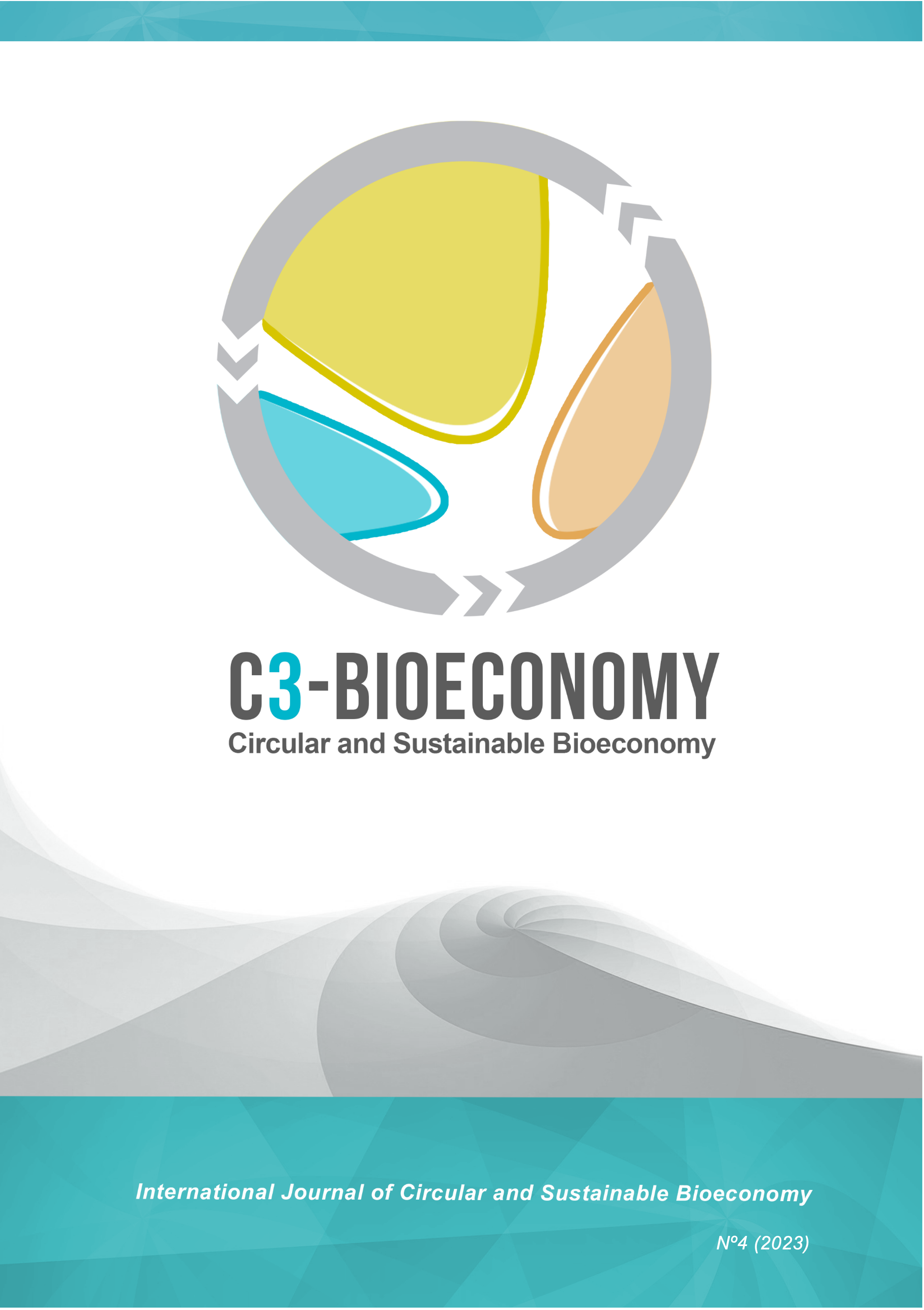Strategic analysis of the implementation of circular bioeconomy in Andalusia through SWOT analysis
Main Article Content
Abstract
This article examines the legislative context of circular bioeconomy at different levels - European, national, and regional - highlighting the favorable regulatory environment that has enabled Andalusia to progress towards an economic model based on circular bioeconomy. Additionally, it presents the European project ROBIN, which stands as an innovative platform for the evolution of governance models in this field, fostering the updating and improvement of the Andalusian Circular Bioeconomy Strategy. Furthermore, it emphasizes the significant potential offered by Andalusia's wide range of biomass resources, positioning the region at the forefront of the circular bioeconomy. Moreover, a SWOT analysis is conducted to identify the region's strengths, weaknesses, opportunities, and threats, thus contributing to the advancement of the current circular bioeconomy model. Finally, future challenges implied by the development of circular bioeconomy in Andalusia are identified, and how the ROBIN project can play a key role in advancing towards enhanced governance and a financially sustainable model.
Downloads
Publication Facts
Reviewer profiles N/A
Author statements
Indexed in
-
—
- Academic society
- N/A
- Publisher
- Universidad de Córdoba
Article Details

This work is licensed under a Creative Commons Attribution-NonCommercial-NoDerivatives 4.0 International License.
Proposed policy for journals offering open access. Those authors who publish in this journal accept the following terms:
a) Authors will retain their copyrights, but guarantee the journal the right to the first publication of their work, which will be simultaneously subject to the Creative Commons Recognition License , which allows third parties to share the work provided that the author and initial publication in this journal is indicated.
b) Authors may subscribe other non-exclusive license agreements for the distribution of the work published (for example: place it in an institutional electronic archive, or publish it in a topical volume) provided that the initial publication in this journal is duly noted.
Authors are allowed and even encouraged to disseminate their work via the Internet (e.g., in institutional electronic files or on their website) before and during the submission process, as this can foster valuable exchanges and increase citations of the work published. (See The effect of open access).
References
BERBEL, J., & DELGADO, MM. (2017). La economía y la bioeconomía en el sector del olivar y del aceite. En: J.A. Gómez, & M. Parras (Coordinadores). Economía y comercialización de los aceites de oliva. Factores y perspectivas para el liderazgo español del mercado global (pp. 397 – 412). Cajamar Caja Rural. Recuperado de: https://publicacionescajamar.es/wp-content/uploads/2023/03/economia-y-comercializacion.pdf
BERBEL, J., BORREGO, M.M., GÓMEZ, J.A., VILLANUEVA, A.J., CÁTEDRA, M., & CAPOTE, C. (2021). Factores habilitantes y limitantes para el éxito de iniciativas de bioeconomía circular en Andalucía. Recuperado de: https://www.juntadeandalucia.es/sites/default/files/2022-01/Informe_BEC-Andalucia_Publicacion.pdf
BERBEL. J. & BORREGO, M.M. (2021). La bioeconomía circular. Recuperado de: https://economiacircular.org/la-bioeconomia-circular/
CÁTEDRA, M. & SAYADI, S. (2023). Programación INTERCOONECTA 2022-2023 “La bioeconomía circular como elemento clave de innovación para el desarrollo de la nueva ruralidad a través de la MIPME rural centroamericana”. Curso “Aspectos básicos de la bioeconomía circular”. Agencia Española de Cooperación Internacional para el Desarrollo (AECID). Recuperado de: https://intercoonecta.aecid.es/aecid-impulsa-la-recuperacion-economica-de-la-mipyme-rural-a-traves-de-la-bioeconomia-circular
COMISIÓN EUROPEA (2012). Estrategia de Bioeconomía. Recuperado de: https://research-and-innovation.ec.europa.eu/research-area/environment/bioeconomy/bioeconomy-strategy_en
COMISIÓN EUROPEA (2018). Una nueva estrategia de bioeconomía para una Europa sostenible. Recuperado de: https://op.europa.eu/en/publication-detail/-/publication/edace3e3-e189-11e8-b690-01aa75ed71a1/language-en/format-PDF/source-149755478
CONSEJO DE LA UNIÓN EUROPEA (2023). Conclusiones relativas a las oportunidades de la bioeconomía a la luz de los retos actuales, con especial insistencia en las zonas rurales. Recuperado de: https://data.consilium.europa.eu/doc/document/ST-8194-2023-INIT/es/pdf
EGEA, F.J., LÓPEZ, M.D., OÑA, P., CASTRO, A.J., & GLASS, C.R. (2021). Bioeconomy as a transforming driver of intensive greenhouse horticulture in SE Spain. New Biotechnology, 61, 50–56. doi: https://doi.org/10.1016/J.NBT.2020.11.010
JUNTA DE ANDALUCÍA-a (2023). Ley 3/2023, de 30 de marzo, de Economía Circular de Andalucía. Recuperado de: https://www.juntadeandalucia.es/boja/2023/67/BOJA23-067-00055-6439-01_00281478.pdf
JUNTA DE ANDALUCÍA-b (2023). Caracterización del sector agrario y pesquero de Andalucía. Serie C-19. Recursos biomásicos de la agricultura y la ganadería, 428-432. Serie C-20. Recursos biomásicos de la agroindustria, 433-443. Recuperado de: https://online.1stflip.com/dxnb/3lug/
JUNTA DE ANDALUCIA-c (2015). Plan Director del Olivar. Recuperado de: https://www.juntadeandalucia.es/sites/default/files/2020-03/Plan%20Director%20del%20Olivar.pdf
PROYECTO INTERREG REINWASTE (2021). REmanufacture the food supply chain by testing INNovative solutions for zero inorganic WASTE. Recuperado de: https://reinwaste.interreg-med.eu/
PROYECTO EUROPEO ROBIN (2023). Deploying circular BIOecoNomies at Regional level with a territorial approach. Recuperado de: https://robin-project.eu/
SAYADI, S., RODRÍGUEZ, C.R., ROJAS, F., PARRA, C., PARRA, S., GARCÍA, M. DEL C., GARCÍA, R., LORBACH-KELLE, M.B., & MANRIQUE, T. (2019). Inorganic Waste Management in Greenhouse Agriculture in Almeria (SE Spain): Towards a Circular System in Intensive Horticultural Production. Sustainability, 11 (14), 3782. doi: https://doi.org/10.3390/SU11143782
SAYADI, S., TORRES, J.M., PARRA, S., GARCÍA, M.C., & PARRA, C (2020). Critical point analysis in solid inorganic waste production in the protected cultivation systems in Almeria – approaches to reduce the impact. ISHS Acta Horticulturae, 1268, 205-212. doi: https://doi.org/10.17660/ActaHortic.2020.1268.27
SAYADI, S. (2023). Foro de Bioeconomía Circular, organizado por la Consejería de Agricultura, Pesca, Agua y Desarrollo Rural. Mesa de diálogo: cadena de valor de la bioeconomía. Recuperado de: https://www.forobioeconomiacircular.com/
VILLANUEVA, A.J., & LA CAL, J.A. (2023). La bioeconomía circular en el olivar: el reto de pasar de la gestión de residuos a la valorización de subproductos. Mercacei. Febrero. Recuperado de: https://www.mercacei.com/noticia/58236/actualidad/bioeconomia-circular-en-el-olivar:-el-reto-de-pasar-de-la-gestion-de-residuos-a-la-valorizacion-de-subproductos.html


